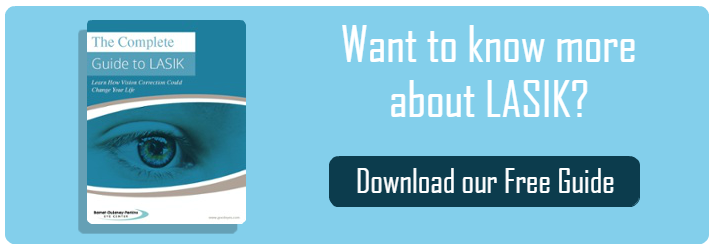
Since the first laser vision treatment was performed in 1988 through photorefractive keratectomy or PRK (a predecessor of today’s LASIK), laser eye treatment technology has significantly evolved and continues to improve. With these improvements, many have turned to laser eye treatment to correct vision problems and ideally eliminate the need for contacts and eyeglasses.
At Barnet Dulaney Perkins Eye Center, questions always come up about what’s new in LASIK technology. In this article, you will learn about topographic-guided laser eye treatment and figure out if you are a LASIK candidate.
Quick Look on LASIK
Normally, clear vision is a result of light rays focused sharply on the retina, allowing you to see clearly at all distances. Refractive errors occur when light rays tend to focus in front or behind the retina. Often, this is a result of an irregularly-shaped cornea.
To address refractive errors, LASIK (Laser-Assisted In-situ Keratomileusis) is used to reshape the cornea and consequently improve vision. If you’re nearsighted, laser is used to flatten your overly steep cornea. Farsighted folks rely on the laser surgery to achieve a steeper cornea. If you have astigmatism, the laser is used to transform an irregular cornea into a more “normal” shape.
Latest LASIK technology in 2016: Topography-Guided LASIK
Topography-guided LASIK is the latest and most advanced form of customized LASIK technology.
The U.S. Food and Drug Administration approved this technology in 2013 and it became commercially available in November 2015 through Alcon’s Contoura Vision. The technology has been available outside the United States for several years with high patient satisfaction rates.
At Barnet Dulaney Perkins Eye Center, we use Contoura Vision for a personalized approach to improving nearsightedness or nearsightedness with astigmatism. To speak somewhat technically for a moment, our topography-guided LASIK combines the Allegretto Wave Eye-Q 400 Hz excimer laser with the Wavelight Topolyzer Vario to create a highly personalized treatment plan for our patients.
The Topography-Guided LASIK Advantage
Before topography-guided LASIK was approved by the FDA, custom or wavefront LASIK was the standard laser vision correction of choice for many. This method could be further split into wavefront-guided LASIK and wavefront-optimized LASIK.
In contrast to wavefront-LASIK technology, topography-guided LASIK employs even-more-detailed measurements of the surface of the cornea to address vision issues caused by corneal irregularities. Due to its precision and accuracy, patients who opt for topography-guided LASIK receive vision correction that is better than ever, and mapped to each person’s cornea surface.
A 12-month FDA TCAT (topography-guided refractive surgery) clinical trial revealed the following:
- More than 98% of patients would choose it again
- It outperformed glasses and contacts in over 30% of eyes in the study
- 6% of eyes that received topography-guided LASIK treatment achieved 20/20 vision or better, 64.8% experienced 20/16 vision or better, and 34.4% could see 20/12.5 or better a year after surgery.
- It reduced the occurrence of common post-LASIK complications such as light sensitivity, glare, difficulty driving at night, and struggles with reading.
Best Candidates for Topography-Guided LASIK
Based on the outcomes of the clinical trial, the FDA recommends topography-guided LASIK if:
- You have less than minus eight diopters of nearsightedness (translation: things get blurry about 8 meters from your eyes)
- You do not have severe astigmatism (minus three diopters or less)
- You do not have more than minus nine diopters of nearsightedness and astigmatism combined
- The amount of nearsightedness with or without astigmatism in your eye did not change by more than 0.5 diopters during the year before your preoperative examination.
- You are at least 18 years old
- You have a stable vision correction prescription
- You do not suffer from excessively dry eyes
An Informed Decision is the Key to Patient Satisfaction and Safety
The Barnet Dulaney Perkins Eye Center aims to provide you with the most recent updates on LASIK technology and help you make informed LASIK decisions.
Download our comprehensive free guide to LASIK to find out more about laser vision correction.



